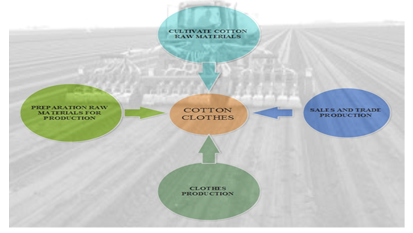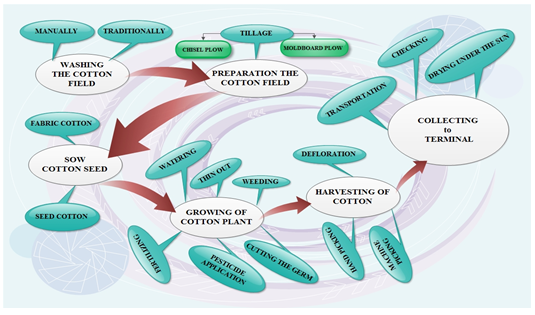From the field to the cotton terminal, via cultivating, planting, growing and picking cotton, this immerses you in the world of cotton by focusing on the first stage in the cotton to cloth supply chain (picture 1):
- Cultivate cotton raw materials.
- Preparation raw materials for production.
- Clothes production.
- Sales and trade production.

Figure 1. Cotton to clothes supply chain
Analysis of each of these will help you understand the economic, environmental and social issues surrounding this raw material, the countless threads of which link Uzbekistan with the rest of the world.
What do we really know about the clothes that protect us during the day, or the sheets that cover us as we sleep at night? Certainly, we are all familiar with the soft fiber most of these are made of cotton. But do we know that where and how our cotton clothes come from? Generally speaking, supply chain means a functional network mode, in which core enterprise stocks raw materials, manufactures intermediaries and production, and last sells the products to the consumer through sales net by controlling information flow, logistics, cash flow.
The figure below shows that there are distinct stages in the cotton fiber supply chain starting at the farm level with the cotton growing. Indeed the supply chain from cotton seed to cotton fiber is unusually long, with a series of stages, inputs, processes and additions necessary. Everything starts on the farm with the washing the cotton field and growing of cotton which involves two major inputs, connection among the each stage and satisfaction of consumers from ultimate products. At the level of cotton growing there is a choice between poor cotton and quality cotton.
A number of points need to be made about this supply chain as they will be important at later stages. This means that final products costs and quality as well as productivity are key drivers in the cotton fiber supply chain. It is significant to go step by step further in this supply chain analysis with the aid of the following Picture 2.

Figure 2. Cotton fiber supply chain
- Washing the fields— Soil washing is a main process that uses water, to remove chemical pollutants and salt from soils. The purpose of soil washing is to first, separate the fine silt and clay particles from the coarser sand and gravel particles and then to facilitate the transfer of these chemical contaminants and salt from the soil surface to the water, which can then be further treated. In Uzbekistan usually there is the main problem soil washing with not chemical pollutants, it is about salinity soil. Soil salinization is a serious threat to agricultural productivity and sustainability of irrigated cropping system in Uzbekistan (Khorezm), though its impact varies over time and space. Washing salinity from the field is conducted in manually and traditionally in region where there is that kind problem.
- Preparation of the cotton field— The suitable land preparation before sowing cotton seeds impacts to the crop strongly. Generally that process means field tillage and the next operations before sowing cotton seed: Bund former; Mould board plough; Chisel ploughs; Drawn leveler; Drawn combined tillage; Drawn harrow tool.
- Sowing cotton seed— Before planting, soak the seeds in fungicide solution for 6 to 10 hours using the recommended fungicides. Then drain and incubate the seeds in a warm, moist place for not more than 12 hours.Only certified seeds should be planted to ensure high seed germination, vigor, varietal purity and uniform field stand. These guarantee high productivity and farm income.
In Uzbekistan, there are more than 20 varieties of cotton seed and they have special characters about getting profit from cotton crops. Each year Uzbekistan is increasing the area sown with faster mature varieties. During the last five years, the government initiated a major program to reform the cotton sector, aimed mainly at improving fiber quality.
During the cotton season, out of all planted cotton seeds utilized for sowing, reportedly 8 % were newly developed breed, 41 % were midseason varieties and 51 % were early ripening breeds. Planting at a rate of 34.0 to 40.0 seed per meter of row in 60centimeter rows and 52.0 to 58.0 seed per meter of row in 90 centimeter rows should provide optimum plant population. Optimal yields are obtained with final stands of 7.0 to 9.0 plants per meter in 90centimeter rows and 5.0 to 7.0 in60centimeter rows. Hill drop planting rate recommendations are the same as conventional planting rates. [1]
- Cotton growing— The cotton takes main part of agriculture sector in Uzbekistan, and it requires some agricultural requirements for growing cotton. Cotton has a long growing season (it can be as long as eight months) so it is best to plant cotton early April, but as late as end of April in raining weather cotton growing will be slowly.
The period from fruiting to finish is important in maintaining the strong foundation for yield and fiber quality that was created during the process of growing. It takes about 5 to 14 days for seedlings to appear after seeds are planted in damp soil. The cotton plant continues to produce squares and flowers for about half the growing season. The last productive flower opens about three to four months after planting. During the cotton growing has to perform the follow operations, often several times and always go hand in hand each other: Hoeing (loosening) after raining; Thin out; Weeding; Fertilizing; Pesticide application; Cutting the germ; Cultivating; Row subsoiling; Watering (Irrigation)
- Harvest-Cotton can either be picked by hand or by machines. Manual picking is slow but better preserves fiber characteristics of cotton. Boll opening is the action on the fiber which pushes fibers from the place where they embedded for weeks before being exposed to the external conditions. Sometimes, a longer stay of open bolls in the field may change the quality of cotton. About 30 % of world production of cotton is machine picked.
Defoliation— For machine picking it is necessary that there are no green leaves on the plant. Under natural conditions, leaves are shed with age but formation of the abscission layer between the main stem/branch and leaf petiole is stimulated by low night temperatures. If the carbohydrate accumulate is slow and leaves are not shed naturally, application of defoliants becomes necessary.
- Collecting to terminal— As of today, the modern ginnery represents a complex scenario of the branch cotton network consisting of ginneries, exterior procuring and storing centers. In the conventional technology of raw cotton processing in Uzbekistan, its manual warehousing and storage in stacks is specific. The stack of raw cotton represents a compacted by tamping (tamped) mass of raw cotton being put on special platforms. This kind of technology of raw cotton store up applied in the Republic of Uzbekistan significantly differs from analogous technologies in other countries and consists in that cotton from farmers is accepted to specialized store up points of gins and is stored on special grounds in the form of bundles with the volume of 350–450 tons each, and at the installed dimensions of platforms as 25x14 m, the height of raw cotton stacking can reach 8 meters in which cotton is stored until processing.
According to the Ministry of Foreign Economic Relations, Investments and Trade of the Republic of Uzbekistan today there are almost 350 specialized raw cotton terminals with the total storage capacity of more than 950 thousand tons of cotton in each region of Uzbekistan.
In this stage all operation with cotton are as follow: Measure the cotton which comes from the field; Checking and Sorting in the special laboratory; Spread the cotton out on the ground and dry in the sun; Make bundles of cotton.
The cotton fiber supply chain is long and complex, as we talked above, with the complexity arising from a number of characteristics, including:
- Cotton from different sources may be combined at various stages: At the sowing, transporting of the seed cotton;
- The change in the form of the seed cotton as it is transformed, in a multitude of processes, from the raw material produced by the farmer to the products sold to consumers;
- Every stage of the process is a potential supply chain cost or benefit and the whole chain is in a state of constant flux as different parts of the chain reduce or increase costs.
References:
- Abdolniyozov B. The Agrotechnical of Cotton in Khorezm, 2004.







